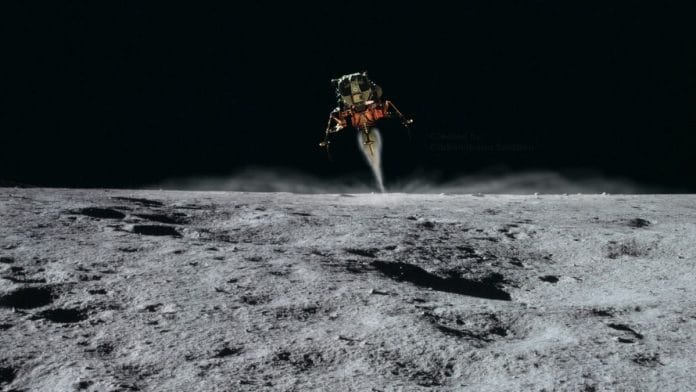New Delhi: With the Indian Space Research Organisation’s ambitious roadmap for its space programme in mind, scientists have proposed Ladakh as a potential site for the country’s first analogue research station where conditions of the Moon and Mars can be emulated to test experiments. Gaganyaan, the country’s first human spaceflight, landing the first Indian on the Moon by 2040, and sending an Indian astronaut to the International Space Station (ISS) are some of India’s aspirational space projects.
A preprint study by Binita Phartiyal from the Birbal Sahni Institute of Palaeosciences (BSIP), Aloke Kumar from the Indian Institute of Science (IISc), and Shubhanshu Shukla, one of the four astronaut designates for the Gaganyaan mission, pitched Ladakh as an ideal site for India’s first analogue research station for its similarity to the lunar topography. Its terrain is also ideal for conducting experiments similar to those that will be conducted in ISRO’s future Mars missions.
“India has set ambitious targets for its space programme and that necessitates the construction of terrestrial research stations that can simulate extra-terrestrial conditions. We believe that this is an opportune time for establishing an analogue research station in Ladakh, benefiting a diverse group of researchers,” the research read.
Phartiyal told ThePrint that most of the existing analogue research sites in the world are located in extreme conditions. This helps researchers conduct space experiments and crew training because the conditions come close to the original mission conditions.
“Ladakh meets all the criteria for a potential analogue research station. The altitude provides it is a semi-arid desert, it has next to no vegetation as it is above the tree line, and it also has a variety of environments such as hot springs, frozen lakes, and hypersaline lakes, which are conditions that are very close to the conditions on the Moon and on Mars. India does not have an analogue station till now. Ladakh will be the perfect location for the first one,” she said.
Elaborating how such a site will help the country’s ambitions of landing the first Indian on the Moon and venturing into more human spaceflight and interplanetary missions, Phartiyal said that apart from just providing training for living in isolation, the analogue research station will also prepare astronauts to collect relevant data in addition to the research work being conducted in the region by the scientists.
“Astronauts will require training in a place similar to the original site to ensure the best samples are collected,” she said.
Kumar, however, caveated that at the current stage, this is just a scientific proposal that aims to set the stage for the possibility of such a site in India. ISRO or the government will have to make a decision on actualising this.
“This is a prelude. Since India has taken a leap in its space programme by preparing for its first human spaceflight, such a site will serve great educational purposes. There is a lot of interest in India’s space programme now. An indigenous effort such as this will give a greater thrust to the space programme and research around it,” he told ThePrint.
An analogue research station is a place that has conditions similar to a planet or planetary body in terms of its topography and environment, among others. These stations act as testing grounds for relevant technologies, help advance technology readiness levels (TRL) and engineering integration, and help with human studies, crew training and research around geological, geomorphological, habitability, and life detection, among others.
The similarity in conditions helps scientists replicate interplanetary mission experiments and train astronauts under specific conditions.
Currently, there are 33 analogue research stations in the world. Some of the prominent ones are the BIOS-3 in Russia, which is a closed-loop biodome located at the Institute of Biophysics; HERA at US’s Johnson Space Centre, a two-storey, four-port habitat; SHEE in Europe, a self-deployable portable habitat for extreme conditions; and the Mars Desert Research Station (MDRS) in US’s Utah, which is a private property developed for research, having multiple observatories and an analogue habitat.
Also read: Fossil of extinct human species Denisovan identified in Tibetan plateau, their diet pattern revealed
Why Ladakh has been chosen
Researchers said that Ladakh’s conditions were found to be a close match to the Moon and Mars because its dry, cold, and arid desert has abundant rocky ground, loose rock blanketing the mountain slopes, vast flat land, segregated ground ice and permafrost, rock glaciers, dunes, drainage networks, and catastrophic flooding make it geomorphologically similar to an early Mars and Moon.
“Hanley’s dark skies in Ladakh are also a major astro-tourist attraction. The volcanic rocks and serpentinite exposures, the saline lakes, and the active and hydrothermal systems can give a clue to the processes and chemistry of the Martian grounds (geochemical fidelity),” the findings said.
Researchers also said that while the region was not naturally rich in craters, these can be created, as was done during the preparation of the Apollo missions at the Black Point lava and the Cinder Lake site. At these sites, craters were artificially created to test the working of rovers, vehicles, and equipment, and practise astronaut training.
“Sufficient isolation of the place also encourages the feeling of self-sufficiency and survival among the crew, a requirement for actual missions,” the researchers said.
They added, “The Ladakh environment, characterised by its sub-zero temperatures, limited precipitation, rivers and lakes, comparatively low atmospheric pressure, hot-water springs, and relatively high ultraviolet flux, is an analogue for Mars and the Moon.”
Phartiyal said that BSIP, Lucknow, has recently constituted the Earth and Planetary Exploration Group (EPEG) to look into astro-biological research. According to her, this EPEG group has expertise in chemical sciences, biological sciences, and geological sciences for exploring the Earth and conducting planetary exploration studies in the dedicated theme of ‘Search for Life in the Extra-terrestrial Environments and Beyond’.
(Edited by Radifah Kabir)
Also read: Scientists discover ‘dark oxygen’ produced on deep-ocean floor where the Sun don’t shine






